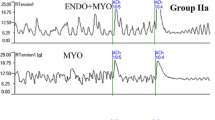Abstract
Objectives:We investigated the hypothesis that the oviduct exhibits increased motile activity during cervical buffeting. Methods: The response of oviductal and uterine pressures to cervix uteri (CU) stimulation was recorded in 16 women (mean age 32.4±3.6 years) with normal menstrual history. Pressure measurements, performed by means of saline-perfused catheters introduced into each of the uterus and oviduct, were recorded upon both electrical and mechanical CU stimulation before and after CU anesthetization. Results: CU stimulation produced a significant uterine pressure decrease with no significant difference between electrical and mechanical stimulation. Latency recorded mean of 17.6±1.2 ms for electrical stimulation and 17.2±1.2 for mechanical stimulation. CU stimulation caused also significant pressure rise in ampullary and isthmic parts of oviduct and a decrease of intramural oviduct with no significant difference between electrical and mechanical stimulation. Mean latency of electrical and mechanical response was 18.7±1.1 ms and 19.1±1.1 ms, respectively. Uterine and tubal pressure showed insignificant response to stimulation of the anesthetized CU. Conclusions: Cervical stimulation reduced uterine and intramural oviduct pressure and elevated pressure of ampullary and isthmic parts. These utero-tubal responses seem to be mediated through a reflex which we call “cervico-utero-tubal reflex” and to assist in sperm-ovum transport and fertilization.




Similar content being viewed by others
References
Braden AEH (1953) Distribution of sperm in the genital tract of the female rabbit after coitus. Aust J Biol Sci 6: 693–705
Brosens I (1991) The Fallopian tube. In: Philipp H, Setchell M, Ginsperg J, (eds). Scientific Foundations of Obstetrics and Gynaecology. 4th ed. Butterworth Heinemann Ltd, Oxford UK, p 135
Halbert SA, Taw PY, Blandau RJ (1976) Egg transport in the rabbit oviduct: the roles of cilia and muscle. Science 191: 1052–1053
Harper MJK (1973) Relationship between sperm transport and penetration of eggs in the rabbit oviduct. Biol Reprod 8: 441–450
Harper MJK (1994) Gamete and zygote transport. In: Knobil E, Neill JD (eds) The Physiology of Reproduction. Raven Press, New York USA, p 123
Hunter RHF (1975) Physiological aspects of sperm transport in the domestic pig, Sus scrofa. II. Regulation, survival and fate of cells. Br Vet J 131: 681–690
Maia H, Coutinho EM (1970) Peristalsis and antiperistalsis of the human Fallopian tube during the menstrual cycle. Biol Reprod 2: 305–309
Muglia U, Vizza E, Macchiarelli G, Germana G, Motta PM (1992) The three-dimensional architecture of the myosalpinx in mammals: an anatomical model for a functional hypothesis. Arch Histol Cytol 55: 171–181
Overstreet JW, Cooper GW (1975) Reduced sperm motility in the isthmus of the rabbit oviduct. Nature 258: 718–719
Shafik A (1996) Electro-oviductogram: a study of the electromechanical activity of the canine oviduct. Gynec Obst Invest 42: 253– 257
Shafik A (1996) Study of the intramural oviduct response to tubal and uterine distension: Identification of tubo-uterine sphincter and reflex. Human Reprod 11: 2527–2530
Verhage HG, Bareither MC, Jaffe RC, Akbar M (1979) Ciliogenesis in the fallopian tube in women. Anat Rec 193: 710–711
Vizza E, Correr S, Muglia U, Marchiolli F, Motta PM (1995) The three-dimensional organization of the smooth musculature in the ampulla of the human Fallopian tube: a new morpho-functional model. Hum Reprod 10: 2400–2405
Vizza E, Muglia U, Macchiarelli G, Baschieri L, Pasetto N, Motta PM (1991) Three-dimensional architecture of the human myosalpinx isthmus. Scanning electron microscopy after NaOH digestion and ultrasonic microdissection. Cell Tissue Res 266: 219–221
Warwick R, Williams PL (1975) Reproductive organs of the female. In: Warwick R, Williams PL (eds) Gray’s Anatomy 35th ed. Longman Group Ltd, London UK, p 1354
Yokoyama O, Komotso K, Kodama K et al (2002) Diagnostic value of intravesical lidocaine for overactive bladder. J Urol 164: 340–343
Acknowledgments
Margot Yehia assisted in preparing the manuscript.
Author information
Authors and Affiliations
Corresponding author
Rights and permissions
About this article
Cite this article
Shafik, A., Shafik, I., Sibai, O.E. et al. Oviductal motile response to penile cervical buffeting. Arch Gynecol Obstet 273, 216–220 (2006). https://doi.org/10.1007/s00404-005-0065-3
Received:
Accepted:
Published:
Issue Date:
DOI: https://doi.org/10.1007/s00404-005-0065-3




